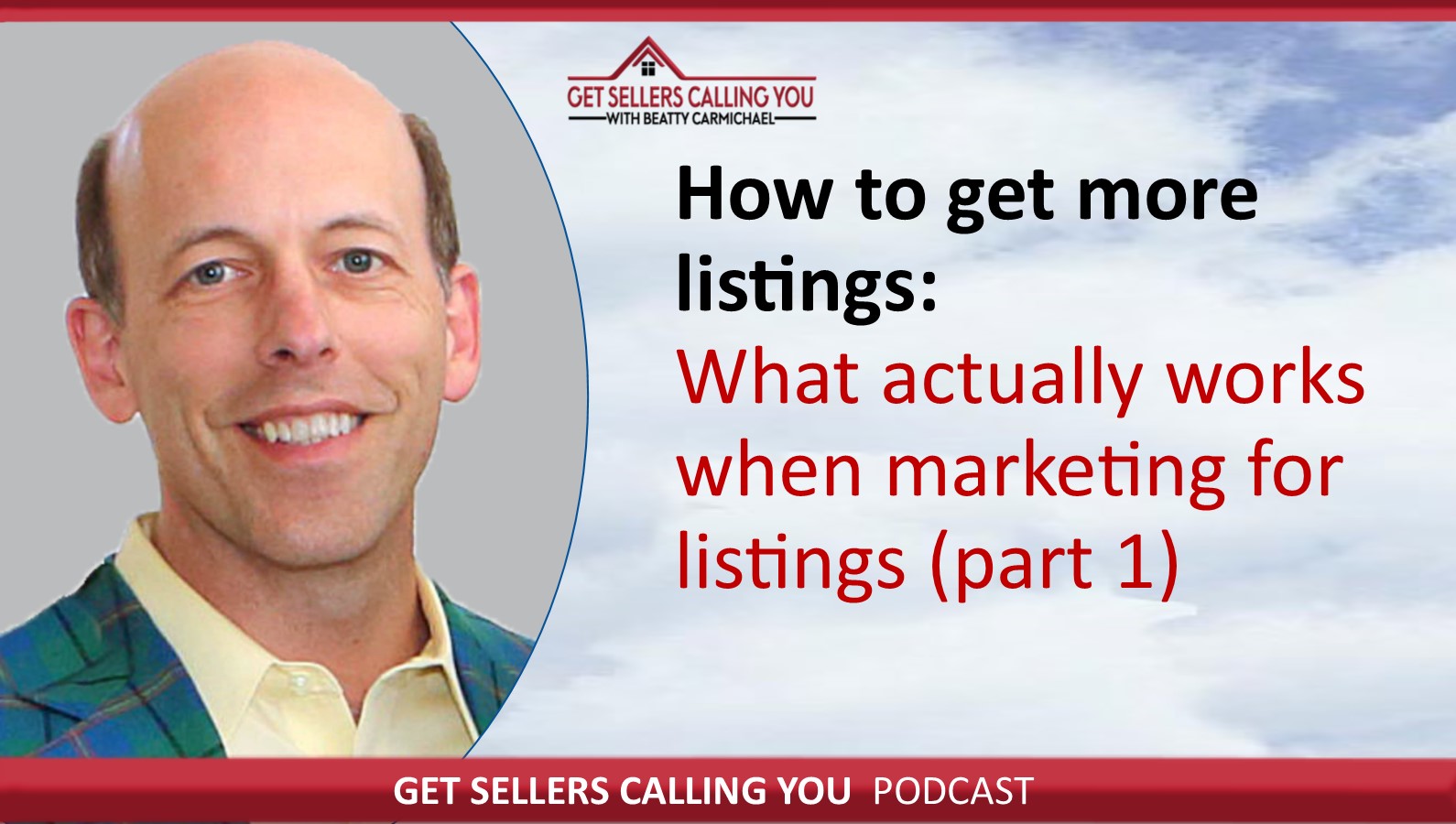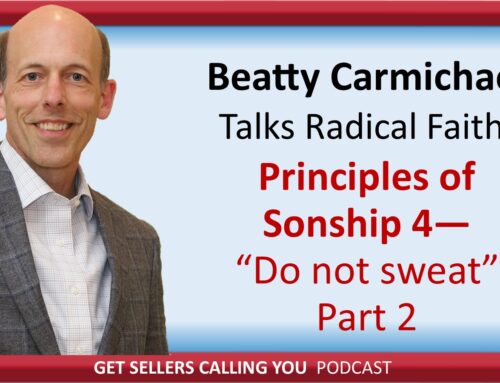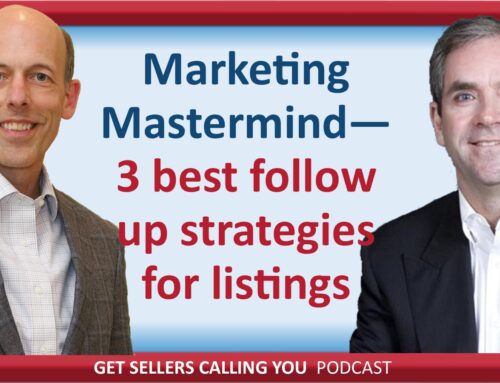Listen via YouTube video if desired
This podcast series is a first-hand account on what I’ve learned from over 43 marketing tests I’ve conducted with real estate agents. Each test was focused towards generating more listings.
In marketing, you’re usually doing good if you can increase results by 20%. You’re doing great if you can increase results by 50% or more. Out of these 43 tests, 5 of them increased results between 250% and 800% each!
Transcription (was completed by automated process. Please ignore any speech-to-text errors)
Hi this is Caroline Springer. Welcome to the next session of others calling you with baby Carmichael baby is the CEO of Master rapper creator of agent dominator and he’s one of the top marketing experts in the real estate field. Today we’re gonna be talking about the topic of Marketing Lessons Learned to increase listings and just a reminder for those of you that are on our live call with us. We will have the lines needed but will open up for questions and answers at the end of the call. Well welcome back. I’m excited to get this new little series started and very curious to hear about all of the marketing lessons you’ve learned over the years.
Well I’m excited for this call too because it’s amazing if you look at what agents do in the field some agents work all the time and make only a living wage and others work fewer hours and have a tremendous lifestyle.
Have you ever noticed that.
Yes I have it does seem like there’s usually a pretty large disparity. I’m sure that a lot of our listeners would love to hear any tips or advice that you have so they can be in that top percent. Well it’s not only it’s not just the top percent.
It’s lifestyle is not about making more money. Lifestyle is about having time to enjoy the money. And we’re kind of digressing but moving back toward this topic we’re going to be talking about is so exciting. I was talking to a client of ours and he made a million dollars gross commission income in that year. And a friend of his made like 3 or 4 million dollars GCI in that same year. Now my friend my client is a single producer. It’s just him by himself and his friend was a team leader and he had a whole organization and this monster of a machine to drive in business and what was interesting is my client was telling me when it was all said and done I took home more money than he did. And I worked a lot fewer hours with a lot fewer headaches. And so it’s not so much being a top producer. It’s a matter of how much money do you bring in and how much time do you have to enjoy your life and actually have a life outside of real estate. Are you following what I’m what I’m trying to particularly.
Yes I am. I mean that makes a lot of sense even just hearing that thinking about managing other people in a big team and just the difference there. I’m sure listening would prefer to have lower stress but still bringing home a good paycheck to where you’re able to maintain the lifestyle that you want. So now I’m following I think that makes a lot of sense.
So now let’s tie that back into the topic because a topic marketing lessons we’ve learned about increasing listings. The topic sounds maybe a little boring and I’m not sure the word I want to use but not exciting but the impact of this is cool. The only reason my client was able to take home more money than his friend earning a lot less in total commission income and have more time to enjoy it is because he’s gone through a lot of testing over the years to find out what really works. And if you understand what really works then you can put forth the same amount of effort and get back a lot higher return. And what that means is it takes less time to earn the same amount of money. So that’s really the value proposition for this whole series is how can you earn more money with less effort by doing things right as opposed to doing things wrong. And those are the marketing lessons we’ve learned on how to increase listings. So that’s kind of why for me this is an exciting topic to really kind of talk about.
Well you’re the perfect person to everybody here because I know you’ve had a lot of lessons in marketing over the years. So like you said part of managing your time well is just being willing to receive the expertise from others like you. So I’m excited to get started. Wouldn’t you like to know. Are we going to do an overview of kind of what we’d like to cover in the series. Or would you like to kind of get right down to specifics.
Well let’s do a quick overview. I think that’s a great idea. So people could have a bird’s eye view of where all this goes. So I think the big picture of the overview is when you do marketing and this is whether you’re on radio on postcards face to face if you’re in print if you’re on Facebook ads or anything like that the dynamics are all the same. The tactic may be a little bit different but the strategy is still the same. And what causes people to respond or not or what causes people to be more likely to respond or more fully engage with your marketing pieces all the same. So this is going to go is we’ve conducted a bunch of tests. I think it’s like 43 different marketing tests over the years each one trying to understand what causes an incremental increase in results. Let me ask you just in the big scheme of things this kind of a hypothetical question. Well not really hypothetical but just kind of get this discussion started for a moment. What do you think a 5 percent increase is a lot or a little.
Generally speaking generally speaking a little but I guess it does depend on what the 5 percent increase is.
Okay now watch this. Let’s say you have 20 different steps in some sort of marketing process and you are able to increase 5 percent each step of the way. So you got a 5 percent increase in another five then another five then another five. By the time you finish that entire 20 step process was it just a little bit of an increase or did you make a huge increase in the overall result of what just happened.
Well I would think it would be a huge increase in the overall result. And especially when you backed up and looked at all of your efforts. I’m sure it would feel very large.
Yes. So this is the the art. This is the impact of compounding increase conversion. Some more steps that you can make an incremental increase in conversion rate means that the ultimate outcome of where it all goes is going to be a much larger and very impactful. So we’re constantly been doing this how do we make these incremental state step increases. How do we increase something here and decrease in something there. How do we test it back and forth. And when you connect them all together into a an entire marketing program then you’ve got a really strong overall increase in results. So that’s kind of the big picture overview I think throughout this call we’re going to talk about a lot of things we’ve done most of our testing has been in the postcard world which is just print media and print media can be either digital print like an ad or physical print like a postcard or a printed list such as maybe on a billboard. So all these things are going to be pretty much applicable and transferable anywhere you go. So that’s kind of the big picture overview that I’d like to take us on this on this journey should be a lot of fun and should be really surprising on some of the things that we’ve uncovered and discovered through this process.
Well I’m sure there definitely will be something surprising doing things that hopefully our listeners will take away and kind of take a step back and look at maybe some things that they’ve tried in different ways that they could try listening. I was just thinking is there maybe one suggestion that you have of how to begin looking at. Am I really making these small progressive increase or anything specific that you would suggest as a way to track or kind of where do we get started.
Well I think the first step to get started great question. The first step is if you don’t track it and measure it it’s not marketing. It’s just spending. And I was on a podcast call yesterday and the guy made a brilliant comment on and most agents just spend money and then they look back and say well did I get a listing. Did I did something happen. And they really don’t know because they don’t take the time to track and measure. And unless you take the time to put in place your tracking and measuring process then you’re just spending money. Not sure if it works or not. So I think the first step is obviously you just have to have this attitude. Okay I’m gonna track everything and if I can’t track it I’m not going to do it. If you’re going to run an ad here’s a perfect example. Okay let’s say that you have a website lead capture page and you’re already doing things out there and driving leads into that. And now you get this this idea Hey I want to advertise on this new Web site. So if you go advertise on that new Web site and you have no way of knowing if it generates leads or not then you’re just wasting money. Okay if you have no way of discerning believes that that website generated over all the other leads then you really have no way of measuring if advertising or marketing expense was effective. So that’s why you’ve got to make sure that you’re able to track everything you do. And this is where generally speaking in marketing you have what’s called a split test.
And just kind of lay down you got to control test and a split test a control test is where you have two groups that you’re testing. One is your control group. It’s a known entity in terms of results and then you test something different let me see if this makes sense. So let’s say you you have a form that you’re targeting a geographic farm and you’ve been mailing that farm for several years and you’re getting consistent results. And in simple terms let’s say a thousand home farm. So if you wanted to test something new what you would do is you do a control test. You would divide up farm into 500 homes and another 500 just by randomly. I’d like to randomize things it’s really easy just sort of put in an Excel spreadsheet and sorted by first name and you’re gonna get a really random thing. So you’ll take the first 500 that becomes your control group and the second 500 that becomes your test group. So when that test group you would do whatever it is that you think you’re going to do differently and then over a period of time if it’s a farm maybe over a year you’re then going to look at the control group in the test group and say Was there a noticeable difference good or bad in the test group compared to the control group. And if there is then you can attribute the change to whatever you did. Does that make sense or are you following the process.
I’m talking about no one does. I think that’s a great just even small example of something very easy. Anybody can do either way to really make sure that their marketing efforts are working. So yes I’m following. I think that’s a great idea.
So that’s a control test and then you have a split test. They’re kind of similar and these are my terms so it may not be the official terms but the split test is where you do split a test. Technically the term is where you’re going to test two different things to the same list. So the way that you would do a split test is let’s say I’m going to target a new farm just to keep it simple. I’ve never marketed there is gonna be a thousand home farm and I want to test a new type of direct response postcard. So in that environment what I’ll do is I’m want take five hundred addresses at random and then once send them postcard a I’m going to take the other 500 send them postcard B and I’ve got my tracking process in place so I know which postcard someone is responding to maybe I send someone to website a dot com and the other one they go to website become and I’m able to separate out the responses and then I want to mail that postcard. And then I want to see what type of results in that way I can test one offer against another offer and say which offer performs better. So in a split a test you’re able to test offers pretty easily.
And if I find that offer one does better than offer two then I’ll do another split test with offer one versus offer three and maybe three outperforms one and I’ll do another test with offer three versus four. And real quickly I can identify out of four or five or six offers. Which one is the most responsive all the way down to which one is the least responsive. So that’s the value of tracking. Okay. So then once you have that in place then the last thing is simple I guess you call it crossed X maybe I call it a B. Most people say is ABC Always Be Closing well in marketing is ABC Always Be tracking. And you just have kind of this this mindset that everything you do you’re always tracking you’re always measuring. You never leave anything to chance and you never just spend money where you’re not actually tracking it if you can’t track it just don’t do it because you never know what’s going on you’ll never know whether your investment has been effective. So that’s the kind of high level overview and getting into this topic now for the fun stuff would you like to hear about some of the things we’ve tracked some things we’ve tested and some of the results that produced and.
Yes I would. I always love when you share your history and your experiences and examples are really what kind of hit home and people learn the lessons. I think that’s a great idea I’d love to hear.
Okay great. So let’s start with something simple that might have far reaching impact. So let me ask you a question because this is a great question to ask. You’re looking at an ad and this particular ad is just nothing but text. Okay so let’s think let’s think you’re in a magazine. You just come up with this ad and just nothing but text. You look at another ad and it’s got this gorgeous photo and the Texas overlaid on the photo and it looks really pretty and it looks really gorgeous. Which of those ads attract your attention the most. Which one do you think is likely going to produce the better results.
I would definitely think the one with the photo. I’m a very visual person so I wouldn’t be attracted to the one I would remember.
Great. Now let me ask you a question. Let’s say now that you’re a professional real estate agent and you’re selling into let’s call it a luxury market of some sort and you want to put together a really strong producing marketing pieces and you have two options. One option is to do and let’s just call it a postcard just to keep it real simple. One option is a postcard. That’s just a bunch of words and very few if any pictures. The other option is to do a postcard that says gorgeous postcard gorgeous photography you’ve got fewer words it’s kind of overlaid and really beautifully graphically design right there on the postcard.
Which one as a professional real estate agent selling into that luxury market are you more likely to go with I would think the one with the beautiful photos and the graphics and things like that just because that’s probably going to a luxury market when I think luxury is something that’s hard to even depict a photo showing the luxury I think is something that that consumer would connect to a lot quicker.
Okay perfect. Now final question which of those do you think most agents actually pick.
You think they pick the same thing as well I guess since you’re asking that they don’t pick that.
No no no you’re actually you’re actually wrong on that. They pick the same way. Okay. All right. So I don’t know. No no no no.
These aren’t these aren’t trick questions. These are just engaging in conversation so that folks on the call can kind of be answering the question themselves with what they think they would. So. Here’s what’s really going on. We have a print style that’s the main difference here. Okay. We’ve got some graphics difference. But for the most part what I’ve been articulating is the difference in style and actual print. Either one print is a dark colored font on a light colored background. I would call that normal print or the other one is a light colored font on a dark colored background we call that reverse print because if you have this beautiful photograph then typically you put the you put the words on top of the photograph someplace where it’s kind of darker and you make the words in flight and that’s called reverse print. Does that make sense.
It does. I feel like I have heard you go through this before the letter you have normal print and you have reverse print.
And so with normal print versus reverse print the question is Is there a difference in response rates between normal and reverse. Because that’s one of the things you needed to ask. If you’re going to if you’re going to invest all this money in your marketing budget for this beautiful photography beautiful cards and puts these beautiful words right on top versus something less beautiful and more plain the question is why. In marketing you can never rely strictly on your own personal opinion.
Give me just one quick moment.
What happens then is we make these decisions based on what we like rather than what the market tells us. And if you if you base all of your marketing decisions on what you like rather than what the market tells you then you’re liable to make mistakes and not even know it. So we tested this. We tested what we did is we took the identical postcard identical headline identical everything including the copy on one we put normal print. The other one we put a darker background on it and we put reverse print and we dropped them in the mail. So we did a split a B test we did a couple of thousand mail outs on this and we tracked all the results. What we’re doing is we’re sending out an offer that we knew was performing that would get people to respond and then we tracked how many responded from card a which was the regular print and how many people responded from card B which was the reverse print. And then we tabulated the results. What do you think those cards 1. Do you think the regular print or the reverse print one.
I do. I remember as I remember learning from this and thinking that the results were pretty interesting myself when you heard about I was mentioning that I remember this before. I think naturally I would think that the darker font on a white background would win. But from what I’m remembering I think it’s a pretty stark difference though is that correct.
Right. So the regular print one. Okay. So now let’s talk about 5 percent is a kind of a low increase in conversion. What would you think would be a high conversion rate.
Oh I don’t know 20 to 25 percent.
Okay. So you’re actually right 20 to 25 percent is it really is a strong conversion rate. Anything above that is a really strong conversion rate. Does that make sense right. Okay. So what type of conversion rate would you think if the regular print went over reverse print.
What type of conversion rate do you think it may have won by Okay well let’s shoot for higher than maybe it was in 70 80 percent range really high.
Right.
That’s what I’m thinking. Yes. All right.
Now I know you’re guessing at this one because you think this is a leading question right.
Well I don’t know the actual results but I do think just even naturally I do think that people would probably respond to that a little bit quicker. Something that they’re more familiar with her it feels more just calming and natural and not something out there something that they actually respond to look at. That would be my first thought.
I want to challenge you on this. I kind of want to challenge your response. Earlier you said you would be more attracted to the pretty photo with the words rather than just the words on black and white. So why do you think someone would respond more to more the regular print rather than the reverse print which is a pretty photo.
I thought you were just talking about the font color. I didn’t know that the regular would not have a photo.
Well it may have some imagery there but the main contrast here is a difference between having a photo encompassing the entire card in your print on top of it versus having no photo or smaller photo somewhere else but not putting print on top of that. That’s kind of fast tracked a little bit. So 70 to 80 percent is what you think is the increase. So let me tell you what the test results were. It wasn’t 70 percent and it was an 80 percent. If you could think way out of the box. I won’t tell you it’s higher than that. If you were to take just as real stab you know as far as as far away as you could. What do you think would be the next guess you would have Oh God above 80.
I don’t know.
Ninety five okay. It was you ready. Eight hundred percent difference.
Oh wow.
Think about that for a moment and think about this in terms of you being a real estate agent investing your hard earned money to drive results and whether it’s a direct response card or whether it’s just some other card that you’re just trying to convey information about your expertise or your brand or anything like that. What’s the difference. Why do you think reverse print got eight times fewer results than regular print.
What do you think is driving that.
I do not know because I feel like there is part of me that would think I would respond to a. But you did say both would have it. I don’t know if it’s just that the wording is more clear on the normal printing so they’re not only looking at the photo but they’re actually also reading the words versus the other one they’re mainly just looking at the photo or it’s just that consistency in that being kind of something that people are more comfortable with.
I don’t know the answer because this is really important because anytime you do any sort of marketing you have to keep all of these little things in mind if you want to increase your results. I can guarantee you that my client who makes more money than his friend more take home money and has a greater lifestyle understands these things and applies them. And that’s why he’s so successful. So here’s what you actually hit on it but you didn’t I don’t think you really understood it. Clarity. You saw it. Do you wear glasses by chance or context.
I don’t. Use. I got Lasik eye surgery anyway.
Okay so you used to wear glasses right.
Yes I did.
Okay so let’s say that there was some sort of a billboard or some sort of something over there that you got to read and it was just out of distance and you could barely read. You’d have to squint and and very laboriously tried to read it and then you put your glasses on and you could read it instantly and very clearly. Which one of those is going to make a bigger impact in your life.
I mean the one that I would not have to squint to read definitely make a bigger impact here here’s here’s what’s happening.
If you have to exert a lot more effort and energy to read what it’s saying you’re less likely to take the time to do it. This is too hard. I’m just gonna throw it away. I’m not going to look at it. And by the time you figure it out it’s been so laborious that the impact just doesn’t leave the right impact with you. But if you can just really easily just get it on. Read the whole thing at one time and it’s easy then you’re gonna do that. That’s the difference between regular print regular print and reverse print. We are trained to read Dark print on a light colored background. It’s high contrast. But when you start to put a white print on a dark colored background mentally we’re not trained to read that way. It’s really hard test over a test over test has consistently proven this. In fact the hardest thing to read is all capital letters italics on a white font on a black background. So if you want to make sure that your prospect will never really read what you write then do reverse print all capital letters in italics. Okay. But if you want to easily read what you write then do regular font on a white background. Anything beyond that you’re slowing down their ability to clearly read which means you’re slowing down your ability to clearly communicate. And if you can’t communicate then your marketing loses effectiveness pretty cool it that is I think that was a really good
Through my guinea pig testing. I did think that point was very efficiently communicated. What really does work and what doesn’t. I think that was a good kind of maybe confirmation for a lot of the voters listening in either what they’re doing or what they maybe should change.
Now let’s talk about education because it’s important from a professional standpoint to have beautiful photography. I get it. You want to have a really great look. I get that you want to look professional and beautiful photos help you do it. I get all of that. But what this means is you need to make sure that the majority of whatever content you’re trying to deliver in terms of words to the best of your ability is black print on a white background. So that doesn’t mean you get rid of the photo. It means that you move the photo to a section of the page so that the main section that’s going to have content is going to be white with black back black print. You can still put some words on the photo. We do this all the time with our headlines. We have a dark colored background with reverse print for a headline because it stands out and it’s pretty. But when we get down to the real meat and potatoes of what we’re trying to communicate you’ll find that what we do is always black print on a white background because it makes reading really easy. And if reading is easy we’re more likely to get them to read it which is why the whole purpose of the marketing in the first place.
So that’s a cool thing.
It really is. I think that was a good first example of what you’ve seen be successful in testing and why testing is so important and what a huge difference it can make and show you where you’re really funneling your money and your marketing.
So I guess that’s looking at my clock. I think we’re about out of time and we’re going to uncover a lot of these things that are these little aha moments and you go oh that’s really cool. And you start to connect them all together. Now you got marketing that outperforms everything you’ve ever done.
Well I think this is really great. I’m excited to continue on the series and here are more examples like that that are really have a great outcome and testing so our listeners can learn from what you experience in all of your expertise. But like you said I think we’re out of time for this call. Betty thank you so much for sharing and for your time. I think this really was such a great call. Before we wrap up is there anything else that you would like to share.
Of course I’d like to put an unabashedly plug in for our services because we do this all the time for our clients we apply all these things that we’ve learned and we drive in more results than most people have thought was possible. And we do it through a service we call Agent dominator. So it’s those out there on the call or listening that you’re wanting to say Hey I just want to hire an expert shot trying to be an amateur doing this then checkout agent dominator net. And that will get you over to the side of ours you can learn a little bit about our service that we do we actually guarantee your sales or we’ll give your money back and you can fill out a form and request information one of our team members will get back with you.
Perfect.
Okay. So what we’re gonna do. As we wrap up for those of you that are on the call with us if you have questions you’d like to say just hold on and we will go into a short questions and answer time with him in just a moment. And I think that’s all we have for today.
Thank you for joining in and we will hopefully have you join us next time. Thanks again.
All right thanks guys.
P050








Leave A Comment